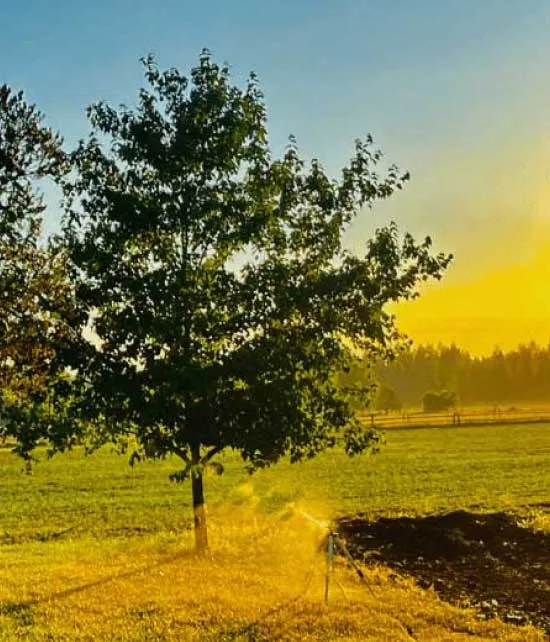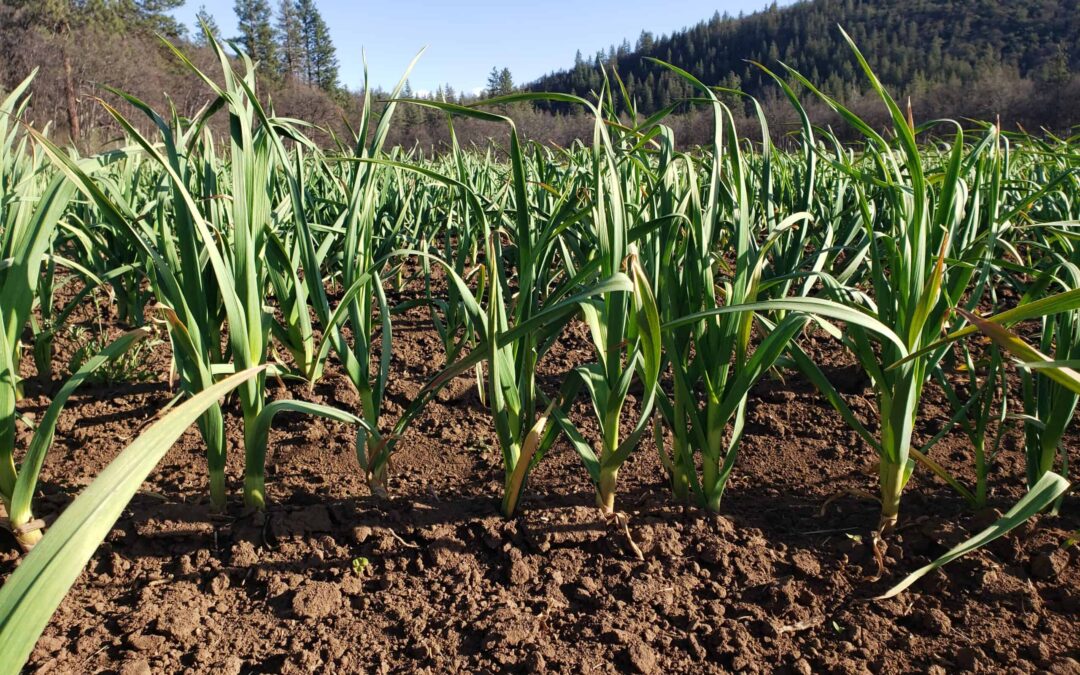Ingredients for two people who love salad with a kick. The salad: 2 large oranges 2/3 cup pomegranate seeds 4oz…
Regenerative Farming

Regenerative Farming
Regenerative organic farming is a holistic agricultural approach that focuses on restoring and enhancing the health of the soil, ecosystem, and community. This method goes beyond sustainable farming by actively improving soil fertility, increasing biodiversity, and promoting animal welfare. Regenerative farmers use practices such as cover cropping, crop rotation, and composting to sequester carbon, improve water retention, and reduce the need for synthetic inputs. This approach not only yields high-quality organic produce but also contributes to the fight against industrial agriculture, keeping contaminants out of water, sequestering carbon and creating nutrient dense food.
Latest Garlic Recipe Articles
The Top 10 Organic Garlic Farms in the US: A Comprehensive Ranking
You may or may not know that way too many non-organic farmers are getting away with false and misleading advertising…
History of Regenerative Organic Farming
The roots of regenerative organic farming can be traced back to traditional farming practices that emphasized harmony with nature. However, it gained significant momentum in the mid-20th century as a response to the negative impacts of industrial agriculture. Pioneers in the field recognized the need for farming methods that could regenerate the land rather than deplete it. Today, regenerative farming is seen as a vital solution to resource and land degradation from industrial agriculture, preserving soil, improving water and sequestering carbon.

Pros and Cons of Regenerative Organic Farming
Pros
- Soil Health: Regenerative farming practices improve soil structure and fertility.
- Biodiversity: Enhances biodiversity on the farm, promoting a healthier ecosystem.
- Climate Resilience: Increases the farm’s resilience to climate change through better water retention and soil health.
- Carbon Sequestration: Helps combat global warming by sequestering carbon in the soil.
- Nutrient-Rich Produce: Yields high-quality, nutrient-dense organic produce.
Cons
- Initial Transition Costs: May require significant investment in the initial transition period.
- Knowledge and Training: Requires extensive knowledge and training for effective implementation.
- Market Access: Farmers may face challenges accessing markets that value regenerative practices.
Common Questions
Getting Started
How long does certification take?
What records do I need?
Can I use manure?
Are greenhouses allowed?
Soil Management
How much compost do I need?
What cover crops work best?
Can I till the soil?
How often should I test soil?
Pest Management
What stops aphids naturally?
How do I prevent fungal diseases?
Do organic pesticides work?
What about deer and rabbits?
Crop Management
When do I harvest garlic?
What spacing do organic crops need?
Which varieties grow best organically?
How do I water organically?
Complete A-Z Glossary
Aphid
Small insect that sucks plant sap
Annual
Plant that completes its life in one growing season
Amendment
Material added to improve soil quality
Allelopathy
When plants release chemicals that affect other plants
Aeration
Adding air to soil by loosening it
Buffer zone
Strip between organic and conventional fields
Broadcast
Scattering seeds or amendments over a wide area
Biomass
Total amount of plant material produced
Biological control
Using living organisms to control pests
Biodynamic
Farming using cosmic rhythms and special preparations
Biodiversity
Variety of living things on a farm
Biennial
Plant that lives for two years
Beneficial insects
Bugs that help farmers by eating pests
Cultivation
Loosening soil to control weeds
Cultivar
Cultivated plant variety
Crop rotation
Changing crops in the same location
Cover crop
Plants grown to protect soil
Compost tea
Liquid fertilizer from steeping compost
Compost
Decomposed organic matter for soil
Companion planting
Growing helpful plants together
Cold frame
Structure protecting plants from cold
Certification
Official approval as organic
CCOF
California Certified Organic Farmers
Catch crop
Quick crop grown between main crops
Cash crop
Crop grown primarily for sale
Carbon sequestration
Storing carbon in soil
Carbon footprint
Amount of carbon dioxide released
Drip irrigation
Water system dripping at roots
Double digging
Deep soil preparation method
Disease resistance
Plant’s ability to fight disease
Direct seeding
Planting seeds in the final location
Decomposer
Organism breaking down dead matter
Fungicide
Substance controlling fungal diseases
Food web
Network of what eats what
Foliar feeding
Spraying nutrients on leaves
Fertigation
Adding fertilizer through irrigation
Fallow
Land left unplanted to rest
Growing season
This time when plants can grow outdoors
Ground cover
Low plants covering the soil
Greenhouse
Structure for controlled growing
Green manure
A cover crop grown for soil improvement
GMO
Genetically Modified Organism
Germination
When seeds begin growing
Hybrid
Plant from two different parents
Humus
Stable organic matter in soil
Herbicide
Chemical that kills plants
Heirloom
Traditional variety saved through generations
Heavy feeder
Plant needing many nutrients
Hardiness zone
Climate region for plant survival
Hardening off
Preparing indoor plants for outdoors
Habitat
Natural home of plants or animals
IPM
See Integrated Pest Management
Invasive
Non-native species causing harm
Intercropping
Growing multiple crops together
Integrated Pest Management
Multiple pest control methods
Insectary
Area attracting beneficial insects
Inoculant
Beneficial bacteria for seeds
John Jeavons
Developer of bio-intensive method
Kelp meal
Seaweed fertilizer
Loam
Ideal soil texture
Living mulch
Ground cover plants as mulch
Light feeder
Plant needing few nutrients
Legume
Nitrogen-fixing plant family
Leaching
Nutrients washing from soil
Mycorrhizae
Beneficial root fungi
Mulch
Material covering soil surface
Monoculture
Growing only one crop
Microorganisms
Tiny soil life forms
Micronutrients
Nutrients needed in small amounts
Microclimate
Small area with unique conditions
Nutrient cycling
Movement of nutrients through the system
NPK
Nitrogen, Phosphorus, Potassium
No-till
Farming without turning soil
Nitrogen fixation
Converting air nitrogen to plant food
Nematode
Microscopic worm
Natural farming
Growing without synthetic inputs
Organic matter
Dead plant and animal material
Open-pollinated
Plants breeding true from seed
OMRI
Organic Materials Review Institute
Predator
Organism eating other organisms
Polyculture
Growing many crops together
Plant family
Related plant groups
Photosynthesis
Plants making food from sunlight
pH
Soil acidity or alkalinity measure
Permaculture
Permanently sustainable agriculture
Perennial
Plant living many years
Pathogen
Disease-causing organism
Quick release
Fast-acting fertilizer
Row cover
Fabric protecting crops
Rhizosphere
Soil zone around roots
Raised bed
Garden bed above ground level
Symbiosis
Organisms helping each other
Sustainable
Can continue indefinitely
Succession planting
Staggered planting for continuous harvest
Soil test
Analysis of soil contents
Soil structure
How soil particles arrange
Soil amendment
Material improving soil
Sheet mulching
Layering materials to build beds
Solarization
Using the sun to kill soil pests
Season extension
Techniques for longer growing
Transplant
Moving the plant to a new location
Transition period
Three years to organic
Trap crop
Plant attracting pests away
Trace minerals
Elements needed in tiny amounts
Topsoil
Upper soil layer
Tilth
Soil’s physical condition
Tillage
Turning or breaking soil
Thinning
Removing extra plants
USDA Organic
Federal organic program
Volunteer
Self-sown plant
Vermicompost
Worm-made compost
Windbreak
Plants blocking wind
Weed suppression
Preventing weed growth
Water holding capacity
Soil’s water storage ability
Xerophyte
Drought-tolerant plant
Yield
Amount harvested
Zone
Climate region for plants

